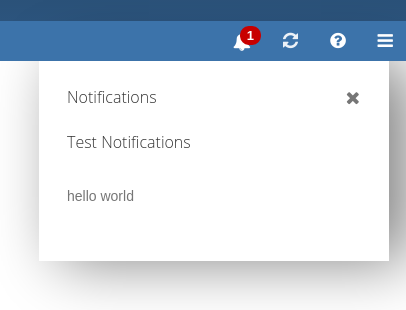AppSuite:Writing a notification area plugin
Abstract: This article is a step by step tutorial to build your own notification plugin. These plugins can be used for various purposes, for example reminding the user of something or showing him new invitations.
Basic Notification
First let's start with showing the most basic notification plugin you can write. Create a file named register.js at plugins/notifications/tutorial.
This code doesn't have api suppport or other things but adds a hello world notification:
define('plugins/notifications/tutorial/register', [
'io.ox/core/extensions',
'io.ox/core/notifications/subview'
], function (ext, Subview) {
'use strict';
ext.point('io.ox/core/notifications/tutorial/item').extend({
draw: function () {
this.append( $('<span>').text('hello world'));
}
});
ext.point('io.ox/core/notifications/register').extend({
id: 'tutorialplugin',
index: 1000,
register: function () {
var options = {
id: 'io.ox/tutorialplugin',
title: 'Test Notifications',
extensionPoints: {
item: 'io.ox/core/notifications/tutorial/item'
}
},
subview = new Subview(options);
subview.resetNotifications({ id: 'myNotification1' });
}
});
return true;
});
This code extends two extension points: io.ox/core/notifications/tutorial/item and io.ox/core/notifications/register
We use io.ox/core/notifications/tutorial/item to draw our notification items. Here it's a simple hello world text.
io.ox/core/notifications/register is used by the notification area to load the different plugins. Those plugins are implemented as subviews of the main notification area. The index determines the order of the different subviews. We define some options for our view here:
- id: the internalId for our subview
- title: the text in the header of our subview
- extensionPoints: here we tell the subview which extensionpoints to use when drawing our notifications. For now we only use io.ox/core/notifications/tutorial/item to draw our items.
More options will be explained later on.
Now we create our view and add notification to it:
subview = new Subview(options);
subview.resetNotifications({ id: 'myNotification1' });
Adding a manifest
Now we need to add a manifest.json file at plugins/notifications/tutorial with the following contents:
{
"namespace": "io.ox/core/notifications",
"requires": ""
}
This manifest makes sure our code is loaded. You can also define capabilities like webmail here, if your notifications require specific capabilities to be enabled. They only show up if a user has these capabilities.
Testing our notification
Now it's time to test our notification. Build the UI and add &customManifests=true to the url, because our manifest is only present locally.
After reloading you should see something like this:
Expanding our Plugin
We can add more functionality to our plugin by using the options when creating the subview. Here are some more:
- showHideAllButton: Is used to show a hide all button for your subview. This button hides all current notifications of your subview. Default is false,
- hideAllLabel: Is the aria-label for the hide all button that is used by screen readers. Default is empty string,
- showHideSingleButton: Is used to show a hide button for your notifications. This button hides a single notification of your subview. Default is true
- max: The maximum number of displayed notifications in this subview. The actual collection may contain more. Setting this to null will show all notifications. Default is 10,
- autoOpen: Used to open the notification area, if there is a new notification for your plugin. You may want to tie this to a user setting. Default is false.
